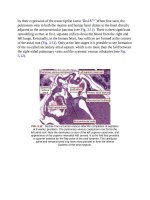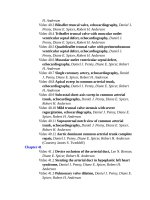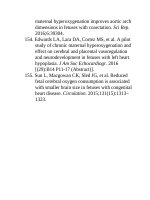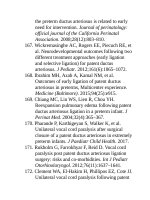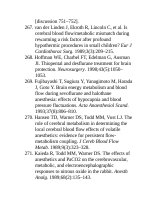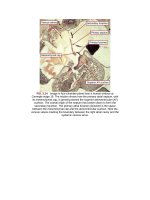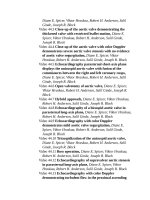Andersons pediatric cardiology 2111
Bạn đang xem bản rút gọn của tài liệu. Xem và tải ngay bản đầy đủ của tài liệu tại đây (139.71 KB, 3 trang )
dosingcomparedwiththetraditionalfixed-doseapproach.53Despite
improvementwithapharmacogenetic-basedalgorithmcomparedtotraditional
fixeddosing,thesepharmacogenetic-basedalgorithmsstillresultedinmorethan
50%ofthepatientswithsubtherapeuticand/orsupratherapeuticpredictions.
Overall,therehavebeensubstantialgainsinthedevelopmentand
implementationofcombinedclinicalandpharmacogenetic-basedwarfarin
dosingalgorithmsinpediatrics,buttheystillrequirefurtherrefinement.
Clopidogrel,anirreversiblepurinergicP2RY12receptorinhibitorpreventing
ADP-inducedplateletaggregation,isadministeredasathienopyridineprodrug
thatrequiresCYP-mediatedbioactivationtoformitsactivemetabolite.54,55The
majorityoftheexistingpharmacogeneticdatarelatedtotheinfluenceof
CYP2C19allelicvariationonbleedingandotheradverseevents(e.g.,stent
thrombosis)residesinadultswithacutecoronarysyndromeundergoing
percutaneouscoronaryinterventions(PCIs).Oneormoreloss-of-function
allele(s)(e.g.,CYP2C19*2,CYP2C19*3)reduceactivationofclopidogrel,
leadingtoasignificantlylowersystemicexposure(e.g.,AUC)ofactive
metabolitescomparedwiththosewiththereferencegenotype
(CYP2C19*1/*1),56leadingtoadecreasedpharmacodynamicseffect(e.g.,lower
inhibitionofplateletaggregation)andincreasedriskofthromboticevents.56–58
Utilizationofclopidogrelinchildrenwithcongenitaloracquiredheartdisease,
comparatively,hasbeenlimited.Amonginfantswithasystemic-to-pulmonary
arteryshunt,clopidogrel,asdualtherapywithaspirin,failedtoimprovetherate
ofshuntthrombosiscomparedwithaspirinasmonotherapyintheClopidogrelto
LowerArterialThromboticRiskinNeonatesandInfantsTrial(CLARINET)
trial.59Fromadevelopmentalpharmacologyperspective,thequestionarises
whethertheseyoungerinfants,duetoCYP2C19immaturity,hadinsufficient
CYP2C19expressiontoevenactivateclopidogrelandthuspreventplatelet
aggregation.Ofnote,thereissignificantvariabilityinCYP2C19expression
amonginfantsandchildrenintheaforementioneddatafromKoukouritakiet
al.22secondarytoontogenybutadditionallyduetoCYP2C19geneticvariation.
AbsentfromtheCLARINETtrialwastheindividualCYP2C19genotypeto
ascertainwhetherthoseintheclopidogrelarmhadloss-of-functionCYP2C19
alleles.CPICguidelinesrecommendconsideringanalternativeagentinpoor
(e.g.,CYP2C19*2/*2,*2/*3,*3/*3)orintermediate(e.g.,CYP2C19*1/*2,
*1/*3)metabolizers.27ObviouslytherearefewdataregardingthegenotypephenotyperelationshipofCYP2C19inthedevelopingchildtoincludeformally
intheCPICguidelines,butsecondaryanalysesofexistingpharmacodynamics
datasetscouldprovidepreliminarydatatojustifyandinformprospectivetrials
involvingthepharmacogeneticimpactonclopidogrelorotherCYP2C19
substratesduringchildhood.
Statins
3-Hydroxy-3-methyl-glutarylcoenzymeA(HMG-CoA)reductaseinhibitors
(statins)arenowthemainstayofpharmacologictreatmentforadultandpediatric
hypercholesterolemiaduetotheirdemonstratedefficacyintheprimaryand
secondarypreventionofcoronaryarterydisease.60–64Todate,pediatricstatin
trialshavefocusedonshort-termlipidloweringandsafetyoutcomes.65–74Three
double-blind,randomized,placebo-controlledtrialsofpravastatinand
simvastatininchildrenhavedemonstratedanapproximate25%to35%and40%
reductioninlow-densitylipoprotein(LDL),respectively,validatingtheir
efficacyinthisagegroup.67,68,70Ofconcern,dailyadministrationofrelatively
highdosesforgreaterthan36weekswasaccompaniedbyaconsiderable
(~fourfold)interindividualvariabilityindrugresponseasindicatedbydecreases
inLDL.67,68,70Withfewexceptions,exposuretostatinshasconferrednoadded
short-termsafetyriskcomparedwithplacebo.However,intheexistingpediatric
trials,thedurationoftherapyrangedfrom1monthto2years;thustherearefew
datadescribingthesafetyofchronicexposuretostatinsinitiatedduring
childhood.Withthislargedegreeofvariabilityinresponseandunknowneffects
ofchronicstatinadministrationonmaturinggonadalandbraintissues,
determiningthelowestdosethatachievesmaximalresponsewithminimalrisk
oftoxicity(doseoptimization)isofgreatimportanceinthedevelopingchild.
Onepotentialsourceofinterindividualvariabilityinstatinresponseis
variabilityincirculatingplasmastatinconcentrations,referredtoasthesystemic
exposure,duetogeneticvariationinthedrugtransportersresponsibleforthe
translocationofstatinsacrossmembranes.Inparticular,thec.521T>Csinglenucleotidevariant(SNV;rs4149056)intheSLCO1B1geneencodingthehepatic
drugtransporterOATP1B1affectsthelocalizationofthetransporteronthe
basolateralmembraneofthehumanhepatocyte(Fig.79.4).75Thefunctional
consequenceofthisSNVisdecreasedhepatocyteuptake75andincreased
systemicstatinexposure.76,77InvestigationsbyNiemietal.76andPasanenet
al.77havedemonstratedthattheSLCO1B1c.521T>Cvariationisassociatedwith
asignificantincreaseinpravastatinandsimvastatinacid(SVA)AUCcompared
withsubjectshomozygousforthefullyfunctionalreferenceallele(c.521TT
genotype).Clinicallysignificantadverseevents(i.e.,myalgias)arereportedto
begreatestinthepresenceofc.521Calleles78,79becauseofincreasedsystemic
exposure.Althoughsomestudieshavealsodemonstratedanassociationbetween
lipidloweringandtheSLCO1B1c.521T>Callelicvariant,80,81anequalnumber
ofpublicationshavefoundnoeffectofSLCO1B1c.521T>ConLDL
lowering.82,83CPICdosingguidelinesforsimvastatinbasedonSLCO1B1
genotyperecommendthatpatientswithintermediatetolowOATP1B1function
havealowerdoseofsimvastatinoranalternativestatin(e.g.,pravastatin,
rosuvastatin)prescribed.84Currentlytherearenorecommendationswithregards
tostatindosingaccordingtoSLCO1B1genotypeinchildren.However,recent
datafromapharmacogenomics-drivenpharmacokineticanalysisinvolving
pravastatinandsimvastatindemonstratethatthemagnitudeoftheSLCO1B1
effectinchildrenistwofoldgreatercomparedwiththatobservedinadults.85,86
FIG.79.4 Statindispositionpathwayinthehepatocyte.Hepaticuptakeof
statinsoccursviapassivediffusionoratransport-mediatedprocessbased
onthelipid/waterpartitionpropertiesofthedrugs.Withinthehepatocyte,
statinsblockHMG-CoAreductase(HMGCR),therate-limitingstepof
cholesterolbiosynthesis.Hepaticclearanceintothebile(green)occurs
primarilythrougheffluxtransporterslocatedonthebiliarycanaliculus.
BCRP,Breastcancerresistanceprotein;BSEP,bilesaltexportpump;
HMG,3-Hydroxy-3-methyl-glutaryl;LDL,low-densitylipoprotein;MDP,
multidrugresistanceprotein;NTCP,sodium/taurocholatecotransporting
polypeptide.
